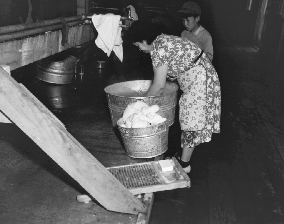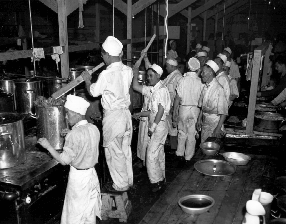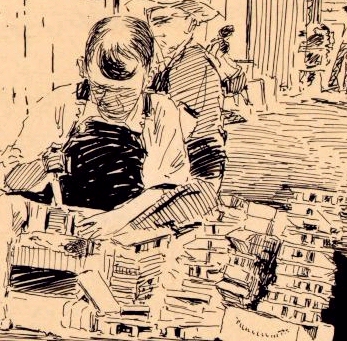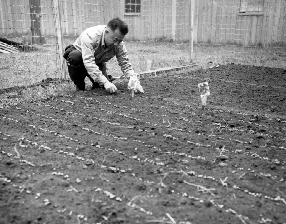Work
The Japanese Americans who came to the camp were farmers, clerks, teachers, fishermen, doctors, and lawyers. Some were poor and others well-to-do, some were well educated, many were bilingual, while others had little formal schooling and no facility with English. Once in camp many class distinctions were blurred. People lived in the same shabby quarters, ate the same institutional food together in mess halls and received the same low pay.
Inmates were encouraged to work as evidence of their loyalty and did work out of loyalty and boredom. They were compensated at the princely sums of $8 per month for unskilled labor, $12 for skilled and $16 for professional level work. As one WRA publication noted: "Opportunities for economic gain in the ordinary sense are almost completely lacking to the residents of the centers."
The government justified the low pay since the camps provided shelter, food and medical care free of charge. In addition each inmate received a free coupon book ($2.50 per adult per month, $1.00 per child) to be used to purchase items at the canteen and monthly clothing allowance.
Everyday chores -- cleaning the one-roomed apartment and doing laundry by hand in metal tubs -- was not compensated.
|
Wages, pay and maintenance of Japanese evacuees. Memorandum for the Assistant Secretary of War from J.L. DeWitt, Commanding General, Headquarters Western Defense Command and Fourth Army dated May 2, 1942. In American concentration camps: a documentary history of the relocation and incarceration of Japanese Americans, 1942-1945. New York: Garland, 1989. WAGES AND HOURS. |
The following schedules of grades and wages, based on a forty-four hour week, will be applicable to evacuees performing work at assembly and reception centers operated by the Army: Unskilled $ 8.00 per month Skilled $12.00 per month Professional and technical $16.00 per month A. Definitions:
Payment for work performed will be made from appropriated funds retroactive to first assignment of evacuee to work after arrival at the center. |
|
Seattle Post-Intelligencer Collection.Museum of History and Industry, Seattle. |
|
|
Questions and Answers for Evacuees: Information Regarding the Relocation Program. San Francisco: War Relocation Authority Regional Office, c. 1942. In the Kaoru Ichihara Papers. Box 1. UW Libraries Special Collections. |
Question 35:Who may enlist in the Work Corps? |
|
Camp Harmony Newsletter, June 17, 1942. |
As far as we're concerned, the angels in camp who have the biggest wings and wear the most luminous halos are the men who man the kitchens. The evacuated life may be a picnic to some of us; to the valiants who sweat that we may eat and live, it's everything but. And so this week's lollipop is extra big, and all of it goes to the cooks. If the grub ain't like it used to be back home, you can't blame the hash artists. The age of miracles never was. |
|
Seattle Post-Intelligencer Collection. Museum of History and Industry, Seattle, Washington. |
|
|
"He Kept Their Toes Dry!" Camp Harmony News-Letter, June 17, 1942. |
So a few ingenious souls set about hewing "getas" out of spare pieces of lumber to solve the problem for themselves. The question, "What is needed to keep the feet dry?" was now answered. But the question, can we all make good "getas" remained unanswered. Many secured the wood and the tools and went to work -- only to trip and curse on their maiden voyages to the showers. Making "getas," it turned out, was not just anybody's job. Anybody can make a pair, yes. But to make a pair which would not endanger life and limb, one needed skill and art and the love of good craftsmanship. And that's where Toyonosuke Fujikado came into glory. Fujikado was one of the few who had solved the problem for themselves, and solved it successfully. Heeding the pleas of others who had not, he converted part of his room at A-5-36 into a workshop. We joined a group of fellow Fujikado fans the other day, and watched the great man at his work. We watched and asked questions and marvelled. He had, he answered, made 700 pairs of "getas" of all sizes and shape and height and people were asking for form. He does not charge for his work. The artisan is surviving the machine age. |
|
"Getas, Getas, Getas and More Getas." Dated July 2, 1942. Eddie Sato Sketchbook and Drawings. UW Libraries Special Collections. |
|
|
"Camp Harmony Japs Living Up to Name." Seattle Post-Intelligencer, May 25, 1942. Pt. 2, page 1. |
And, as if that weren't enough, many of them have put in tiny Victory Gardens. For instance, Clarence Arai, for years a prominent Seattle attorney, has put in radishes, beets, Chinese lettuce and onions -- and his little plot is as meticulously neat as if he were a professional gardener. |
|
Seattle Post-Intelligencer Collection. Clarence Arai in his victory garden. Museum of History and Industry, Seattle. |



